Английский язык, 6 заданий
| Код | 264042 | ||
| Дата создания | 2018 | ||
| Страниц | 6 ( 14 шрифт, полуторный интервал ) | ||
|
Файлы
|
|||
|
Без ожидания: файлы доступны для скачивания сразу после оплаты.
Ручная проверка: файлы открываются и полностью соответствуют описанию.
|
|||
Образцы страниц развернуть (6)
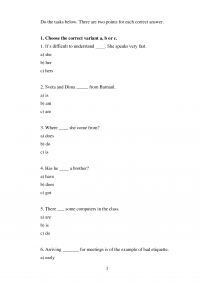

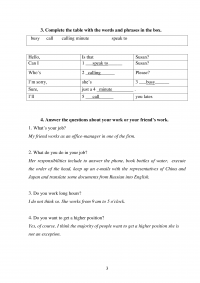
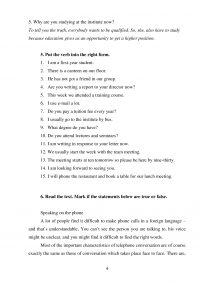
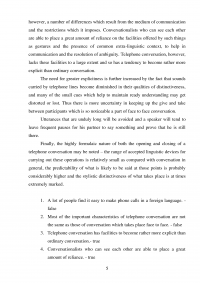
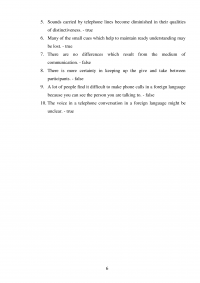
Содержание
Do the tasks below. There are two points for each correct answer.
1. Choose the correct variant a, b or c.
1. It’s difficult to understand ____. She speaks very fast.
2. Sveta and Dima _____ from Barnaul.
3. Where ____ she come from?
4. Has he ____ a brother?
5. There ___ some computers in the class.
6. Arriving _______ for meetings is of the example of bad etiquette.
7. I'd like to arrange an _______________.
8. Do you want to call _______ later?
9. Hold the _______, please.
10. I am _____ forward to recieving your reply.
2. Insert the prepositions.
- My father works ___ an international company.
- He's got a degree ___ BA.
- What university does she study ___?
- She is responsible ___ production.
- Next summer I want to work ___ a salesman.
3. Complete the table with the words and phrases in the box.
busy call calling minute speak to
Hello, Is that Susan?
Can I 1 ___speak to______ Susan?
Who’s 2 _calling______ Please?
I’m sorry, she’s 3 ___busy______
Sure, just a 4 _minute_________ .
I’ll 5 ___call______ you later.
4. Answer the questions about your work or your friend’s work.
1. What’s your job?
...
2. What do you do in your job?
...
3. Do you work long hours?
...
4. Do you want to get a higher position?
...
5. Why are you studying at the institute now?
...
5. Put the verb into the right form.
...
6. Read the text. Mark if the statements below are true or false.
Speaking on the phone
A lot of people find it difficult to make phone calls in a foreign language – and that`s understandable. You can`t see the person you are talking to, his voice might be unclear, and you might find it difficult to find the right words.
Most of the important characteristics of telephone conversation are of course exactly the same as those of conversation which takes place face to face. There are, however, a number of differences which result from the medium of communication and the restrictions which it imposes. Conversationalists who can see each other are able to place a great amount of reliance on the facilities offered by such things as gestures and the presence of common extra-linguistic context, to help in communication and the resolution of ambiguity. Telephone conversation, however, lacks these facilities to a large extent and so has a tendency to become rather more explicit than ordinary conversation.
The need for greater explicitness is further increased by the fact that sounds carried by telephone lines become diminished in their qualities of distinctiveness, and many of the small cues which help to maintain ready understanding may get distorted or lost. Thus there is more uncertainty in keeping up the give and take between participants which is so noticeable a part of face to face conversation.
Utterances that are unduly long will be avoided and a speaker will tend to leave frequent pauses for his partner to say something and prove that he is still there.
Finally, the highly formulaic nature of both the opening and closing of a telephone conversation may be noted – the range of accepted linguistic devices for carrying out these operations is relatively small as compared with conversation in general, the predictability of what is likely to be said at those points is probably considerably higher and the stylistic distinctiveness of what takes place is at times extremely marked.
- A lot of people find it easy to make phone calls in a foreign language. - false
- Most of the important characteristics of telephone conversation are not the same as those of conversation which takes place face to face. - ...
- Telephone conversation has facilities to become rather more explicit than ordinary conversation.- ...
- Conversationalists who can see each other are able to place a great amount of reliance. - ...
- Sounds carried by telephone lines become diminished in their qualities of distinctiveness. - ...
- Many of the small cues which help to maintain ready understanding may be lost. - ...
- There are no differences which result from the medium of communication. - ...
- There is more certainty in keeping up the give and take between participants. - ...
- A lot of people find it difficult to make phone calls in a foreign language because you can see the person you are talking to. - ...
- The voice in a telephone conversation in a foreign language might be unclear. - ...